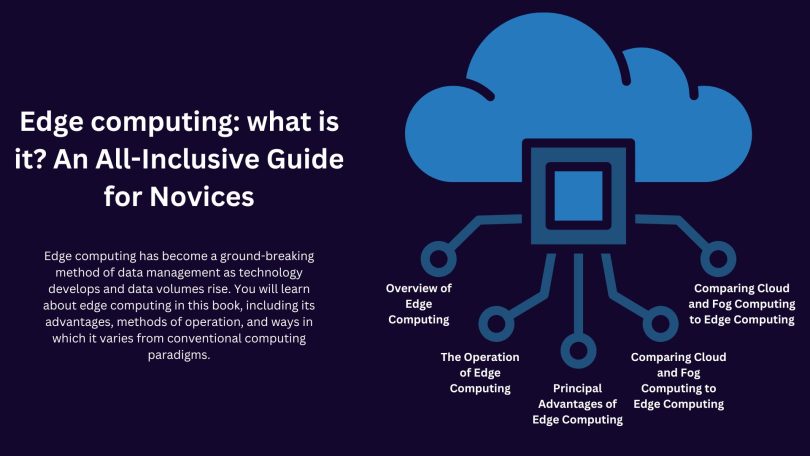Edge computing has become a ground-breaking method of data management as technology develops and data volumes rise. You will learn about edge computing in this book, including its advantages, methods of operation, and ways in which it varies from conventional computing paradigms.
Edge computing:
Edge computing is a decentralized computing approach that brings data processing and storage closer to the data source. Instead of relying solely on centralized data centers, edge computing places computational resources at the network’s periphery, such as local servers, IoT devices, or smart sensors. This strategic shift aims to minimize data transfer distances, reduce latency, and enhance overall processing efficiency.
The Operation of Edge Computing
Data processing has historically involved transmitting information from an endpoint such as a user’s device to a central server or cloud for processing, and then receiving back the processed information. The client-server approach may result in bandwidth limitations and latency problems, particularly as data volumes and the requirement for real-time processing increase.
Edge computing decentralizes data processing to overcome these issues. With edge computing, data is processed locally on edge devices or servers rather than being sent to a central location. By transmitting just necessary data to central servers, this lightens the load on network infrastructure and expedites processing times.
Principal Advantages of Edge Computing
The following benefits of edge computing improve data management’s effectiveness and performance:
Decreased Latency: Edge computing reduces latency by processing data near to its source. This is important for applications like real-time analytics and autonomous cars that need to respond quickly.
Enhanced Efficiency: By minimizing the strain on central servers and networks, local data processing optimizes resource utilization and lowers operating expenses.
Enhanced Reliability: In the event that one edge node fails, the system can still work because data processing is spread over several nodes. The overall system resilience is increased by this decentralization.
Cost Savings: Edge computing lowers bandwidth and storage costs by reducing the quantity of data that must be transported and stored centrally.
Enhanced Security: Local data processing gives you more control over data security and privacy while lowering your susceptibility to network-based dangers.
Support for Remote Locations: Because edge computing allows for local data processing and operation, it is perfect for places with spotty or nonexistent internet connectivity.
Increased Productivity: Quicker decisions and modifications are made possible by real-time data analysis, which raises output levels all around.
Edge Computing Applications
Because edge computing can handle data locally and in real-time, it is being utilized more and more by many businesses. Here are a few noteworthy uses:
Manufacturing: Edge computing enhances production quality and efficiency by optimizing manufacturing processes through predictive maintenance and real-time monitoring.
Retail: By analyzing customer behavior, managing inventories, and personalizing offers, retailers employ edge computing to improve the shopping experience.
Healthcare: Real-time patient monitoring and prompt medical data analysis are made possible by edge computing, which improves patient care and expedites interventions.
Transportation: For the car to perform safely and effectively in dynamic conditions, split-second decisions like steering, stopping, and acceleration depend on this real-time analysis.
Comparing Cloud and Fog Computing to Edge Computing
Its distinct function can be understood by examining how edge computing differs from cloud and fog computing.
Edge computing: This approach moves storage and processing closer to the data source, making it perfect for remote and low-latency applications. By processing data locally, it lowers operating expenses and bandwidth use.
Cloud Computing: Using cloud computing, data processing is centralized in international data centers. It offers a great deal of storage and scalability, but because it depends on internet access, it may have latency and bandwidth problems.
Fog Computing: A middleman between edge devices and centralized cloud services is provided by fog computing. Smart cities are among the dispersed, large-scale environments in which it manages data by extending cloud computing capabilities to the edge of the network.
Conclusion:
Edge computing is transforming data processing by moving storage and processing closer to the site of data production. This technique has a number of important advantages, including reduced latency, increased efficacy, enhanced security, and cost savings.








